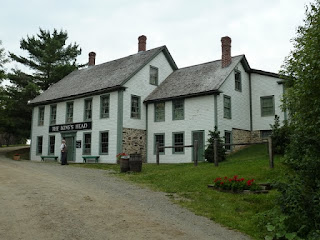I'm writing from Nova Scotia tonight, and I'm about a week behind in blogging. Even with not writing every day, I am behind. I have more to fill my evening hours than I did when I was abroad. When I'm not with friends, I'm out to dinner, setting up camp and cooking, out for a jog, playing WoW, or chatting with friends on Skype. I'm please with my discipline when it comes to getting exercise, but I've been very undisciplined about writing. Anyhoo...
I left Quebec a week ago today and drove east to New Brunswick. I knew I had a lot of time to kill during that day's drive, so I stopped a few random times to see what the roadside attractions were like in eastern Quebec Province and western New Brunswick.
My first stop, still in Quebec, was at Le Musee Francoise Pilote, a museum about agriculture and science. I decided to visit on a whim, I didn't know what the museum contained until I was inside. Anton, if you're reading, you would have loved it. I liked it because it smelled like an old museum, and I learned stuff about farming and animal husbandry.
 |
| Is anyone else a little scared by that top owl? |
The museum also had some non-agriculture related exhibits, like one about computers. I
played on the Appli IIe when I was a kid, and now it's in a museum?! I'm not
that old!
 |
| Photo taken and posted so my mom can see the quilt. |
Later that day, after crossing into New Brunswick, I drove over the world's longest covered bridge. It gets a lot of traffic, actually, and each side has to take turns going through because it's only one lane wide.
 |
| Eat your heart out, Madison County! |
My first major stop in New Brunswick was King's Landing. King's Landing was built in the 1960s when the government dammed the St. John's River, flooding the riverbanks upstream of the flood. To save all of the historic buildings, they were moved to this one spot -- King's Landing -- sometimes piece by piece, and reconstructed there.
Now it's one of those historical villages, where everyone who works there acts in character, but also makes products that are sold to the public (foodstuffs, lumber, printing jobs, etc.) or are used in the town itself. For example, if you go into any of the houses at lunchtime, you'll find the staff gathered around the dining room tables, eating the food that was recently cooked over the open fires or in the cast iron stoves.
 |
| They use old fashioned tools to shape the lumber, then use it or sell it. |
 |
| Scarecrow or 19th Century cheerleader? |
 |
| It's hard to tell in the photo, but these pigs are enormous! |
I stayed several hours but could have stayed longer. However, I had a 5:30 date with the high tide in the Bay of Fundy waiting for me a few hours to the east, so I had to leave kind of early.
If you haven't heard of the Bay of Fundy, it is the place on earth with the largest difference in height between low tide and high tide. I remember learning about the place in 9th grade Earth Science, and when I discovered it was mostly on my path towards Prince Edward Island, I had to stop.
Seeing the Bay at both low and high tides requires a wait of at least 6 hours, and it was most efficient for me to see high tide in the evening, then low tide the next midday. As you can see from the photos, the difference in the height of the water is huge. And I didn't even see the Bay at its absolute highest or lowest.
It's a little freaky, standing on a beach, and seeing the shoreline about 200 yards away, then looking up and knowing that in 6 hours, the shoreline will be 10 feet above your head.
 |
| At high tide, the water reaches up to where the rock mushrooms out. |
















if it's not too late, make sure to do the lighthouse road outside Halifax.
ReplyDeleteSome people in my business refer to places like King's Landing as architectural petting zoos.
ReplyDelete@ Damon: I'll be in Halifax in a few days, I'll check them out!
ReplyDelete@ Nicky: I understand that "petting zoo" thing. But short of not damming the river, I think it's a reasonable way to preserve the buildings. And it's more likely people will visit them as well, and pay to support them.